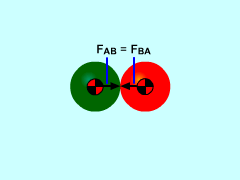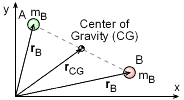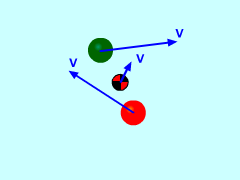| Ch 4. Particle Momentum and Impulse | Multimedia Engineering Dynamics | ||||||
| Impulse & Momentum | Consv. Linear Momentum | Impact |
Angular Momentum |
Mass Flow |
|||
| Conservation of Linear Momentum | Case Intro | Theory | Case Solution | Example |
| Chapter |
| - Particle - |
| 1. General Motion |
| 2. Force & Accel. |
| 3. Energy |
| 4. Momentum |
| - Rigid Body - |
| 5. General Motion |
| 6. Force & Accel. |
| 7. Energy |
| 8. Momentum |
| 9. 3-D Motion |
| 10. Vibrations |
| Appendix |
| Basic Math |
| Units |
| Basic Dynamics Eqs |
| Sections |
| eBooks |
| Dynamics |
| Fluids |
| Math |
| Mechanics |
| Statics |
| Thermodynamics |
| ©Kurt Gramoll |
|
|
||||||||
 Force Interaction Between colliding objects |
Consider a system of two particles, and assume that no external forces are exerted on the system. To describe the interaction between the two particles, begin with Newton's Third Law: "For every action, there is an equal and opposite reaction..." The principle of impulse and momentum can be applied to each particle, giving The subscript 1 and 2 represents the velocity before after the collision, respectively. From Newton's Third Law, the reaction force magnitude on each object must be equal, FAB = FBA In vector format, this means FAB + FBA = 0 Substituting, yields (mAvA2 - mAvA1) + (mBvB2 - mBvB1) = 0 Or simply, mAvA1 + mBvB1 = constant This equation states that if the effects of external forces are negligible, the total linear momentum of a system is conserved. In general (multiple objects), conservation of momentum is |
|||||||
|
|
Combined Center of Gravity |
|||||||
|
Based on the center of mass concept derived in statics, the position of the center of gravity (CG) for the two particles is given by A time derivative can be taken to obtain an expression for the velocity of the combined center of gravity, giving If the total linear momentum of a system is conserved, the velocity of the combined center of gravity is also constant. |
||||||||
Practice Homework and Test problems now available in the 'Eng Dynamics' mobile app
Includes over 400 free problems with complete detailed solutions.
Available at the Google Play Store and Apple App Store.


